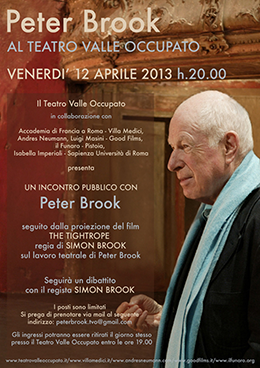Running risks with gerunds and participles
It’s very common to see -ing forms in titles—any sort of titles, articles, music and above all films. Now, -ing forms are not straightforward because the same form is shared by the gerund and the present participle (sharing grammatical resources in this way is very common in English and it inevitably creates confusion).
What’s the difference between the gerund and the present participle?
Both are formed by adding -ing to the base form of the verb.
The gerund makes the verb more like a noun. For example in
I hate working on Saturday.
working is a noun-like verb. Instead, the present participle makes the verb more like an adjective. For example in
a living writer
living has the same meaning as alive, which is an adjective. Sometimes gerunds are used to form nouns (not just noun-like verbs) eg. swimming (the sport). Similarly, participles frequently form adjectives.
One important point for Italians is that there is a difference between Italian and English constructions for the continuous tenses. In
Sto lavando la macchina.
lavando is a gerund. By contrast, even if the meaning is the same, in
I’m washing the car.
washing is a present participle. Remember that English has no equivalent to the Italian verb stare so, at the level of construction, we are saying
sono lavante la macchina
(lavante is the Italian present participle of lavare!)
Keep these distinctions in mind to understand the discussion on how ambivalent titles work. But first, let’s look at some examples of -ing forms in titles.
-ing forms in titles
Here’s a list of recent films and TV-series:
- Eating Raoul (1982)
- Crossing Delancey (1988)
- Driving Miss Daisy (1988)
- Becoming Colette (1991)
- Boxing Helena (1993)
- Leaving Las Vegas (1997)
- Chasing Amy (1997)
- Saving Private Ryan (1998)
- Becoming Mozart (1998)
- Being John Malkovich (1999)
- Finding Forrester (2000)
- Saving Grace (2000)
- Saving Silverman (2001)
- Finding Nemo (2003)
- Raising Hope (2010)
- Running Wilde (2010)
- Being Julia (2004)
- Finding Neverland (2004)
- Raising Helen (2004)
- Taking Woodstock (2009)
They all follow the formula: gerund + proper noun. The question is: Why is this formula so popular?
The first answer lies in the nature of the gerund: its dualism makes it especially useful for titles. The verb part denotes the activity of that verb and the noun part is static making it feel like an abstract concept. This combination gives a dynamic stability that is attractive in titles. See the discussion on Literal-Minded (whom I thank for the list of films) for more details.
The second answer is that some of these titles play with the meaning of the proper noun. These include:
- Saving Grace
- Raising Hope
- Running Wilde
Or better, proper nouns are names and don’t have meanings but these particular names are closely related to normal nouns (or, in the case of wild, an adverb) that do have meanings: grace, hope and wild. These collocate with the verb used in the gerund:
- saving grace is a fixed expression denoting one virtue among many faults
- raise is a collocation of hopes; in combination they mean to increase optimism
- run wild is an idiom meaning to grow, behave without control or influence of authority
This wordplay makes the title feel clever and often the double-meaning is built into the drama.
Grammatically ambivalent titles
There is a second, grammatical, way of creating double-meanings in this sort of title. It involves playing on the fact that the gerund and present participle share the same form and also that, in titles, we don’t have the help from context that usually allows us to distinguish between them. Here are some ambivalent -ing form + noun combinations:
- smoking cigarettes
- demanding tasks
- splitting hairs
- grabbing women
- cleaning equipment
Taken in isolation, they all have double interpretations but if we reintroduce the context everything becomes clear:
- Smoking cigarettes may damage your health.
- Smoking cigarettes can cause fires.
The first sentence means “if you smoke (cigarettes), it may damage your health”. The subject is smoking cigarettes, where cigarettes is object of the verb to smoke.
The second sentence means “cigarettes (that are burning) can cause fires”. The subject is smoking cigarettes, where smoking is a present participle used to denote “cigarettes that are smoking”.
Notice the difference:
- Smoking (cigarettes) may damage your health. gerund
- (Smoking) cigarettes can cause fires. present participle
So looking at the context helps us understand if the -ing form is a gerund or a present participle–essential information for us to be able to interpret the sentence. Conversely, removing the context means that we can’t distinguish between them. Rather like Schrödinger’s cat, both meanings exist simultaneously. In normal language such ambivalence is not usually tolerated but titles are different, perhaps because one function of a good title is simply to excite our curiosity.
Anyway not all such constructions are ambivalent. Let’s look at why.
What governs this ambivalence?
Context again
First, even here context will often defuse potential ambivalence:
- swimming the channel gerund
- swimming pool participle
The reason is that swimming is a common category-adjective for pool: rock-pool, typing-pool, swimming pool. But it’s never used as an adjective for the channel, nor are we tempted to think of absurd meanings like “the channel that swims”, so the potential for ambivalence is not realised in this case.
Everything depends on the nature of the potential object of the gerund. Consider cigarettes and guns. Cigarettes smoke and people smoke cigarettes. However, guns smoke but people don’t smoke guns. Only the former is natural so smoking gun is not ambivalent.
Intransitive verbs
Secondly, when the verb is intransitive, things are even clearer because the gerund interpretation is impossible. Intransitive verbs can form participles:
coming train – ie. “the train is coming” > participle
And they can form gerunds, for example, here, as the subject of a sentence:
Coming is easier than going.
But it’s grammatically impossible to insert an object afterwards
coming trains is …
because coming can’t, by definition, have an object, and if the gerund is impossible, there is no ambivalence.
Mississippi Burning
Before writing this piece, I had never asked myself why the film wasn’t called ‘Burning Mississippi’, but now it all seems obvious—to avoid ambivalence by eliminating meanings where burning is a gerund, ie. where you could read “the burning of Mississippi…”. The producers wanted to restrict the title to the meaning of “Mississippi, which is burning…”.
By the way, you may be asking why it’s possible to put an adjective after the noun. Well, constructions using participles (present and past) are frequent exceptions to the rule about adjectives before nouns in English. This is because they can form clauses like
the man sitting in the corner
Where sitting in the corner is like a multi-word adjective describing which man. These clauses MUST go after the noun. But it’s possible to make very short versions of a clause, eg.
the man sitting
Where sitting is a one-word participle clause. The same thing happens in ‘Mississippi Burning’.
-
MDMA
-
Harikrishnan G
-
http://www.davidnicholson.it/ David Nicholson
-
Ashley Hughes
-
-


